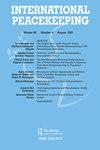The Infrastructure of Peace: Civil–Military Urban Planning in Mali
IF 1.5
2区 社会学
Q2 INTERNATIONAL RELATIONS
引用次数: 0
Abstract
ABSTRACT In the context of the current UN-led stabilization efforts in Mali, the United Nations peacekeeping mission undertakes significant investments in small-scale infrastructure development. The projects not only point to the spatial imprint of peacebuilding on the post-war landscape, but to the imagined performative power of infrastructure. Based on a survey of policy document and official communications, I investigate UN peacekeepers’ narratives of reconstruction, development, and peace promoted through this infrastructure building, and essentially, their role as urban planners in the context of the international military intervention. The account of peacebuilding through infrastructure projects and development resonates with the liberal peace paradigm but also problematizes the practice of civil–military intervention and its focus on infrastructure as device to achieving peace goals.和平基础设施:马里的军民城市规划
在当前联合国领导的马里稳定努力的背景下,联合国维和特派团在小规模基础设施发展方面进行了大量投资。这些项目不仅表明了战后和平建设的空间印记,而且表明了基础设施的想象表现力。基于对政策文件和官方沟通的调查,我调查了联合国维和人员通过基础设施建设促进重建、发展和和平的叙述,以及他们在国际军事干预背景下作为城市规划者的角色。通过基础设施项目和发展来建设和平的描述与自由主义和平范式产生了共鸣,但也对军民干预的实践及其将基础设施作为实现和平目标的手段的关注提出了问题。
本文章由计算机程序翻译,如有差异,请以英文原文为准。
求助全文
约1分钟内获得全文
求助全文

 求助内容:
求助内容: 应助结果提醒方式:
应助结果提醒方式:


